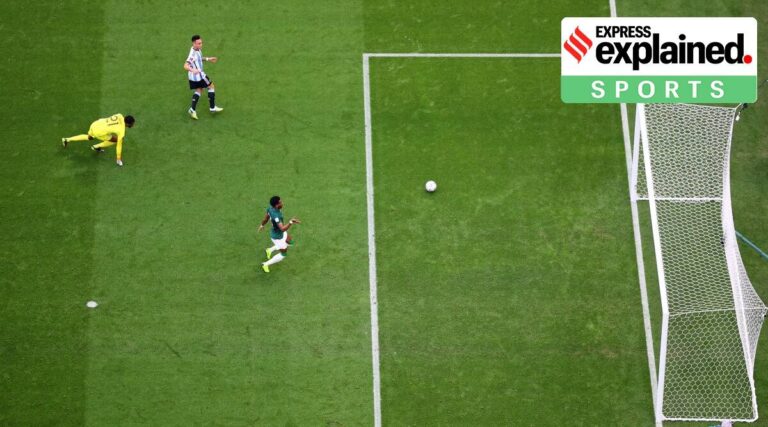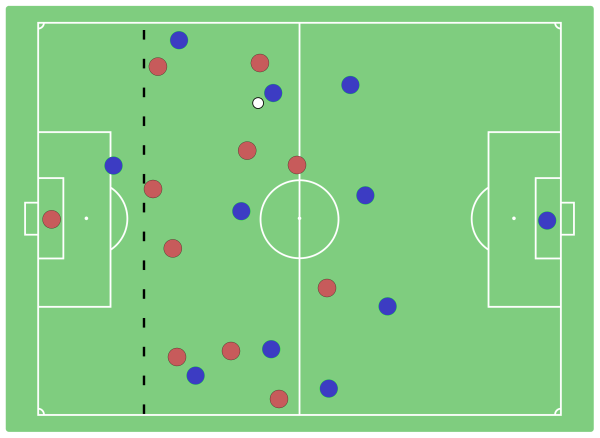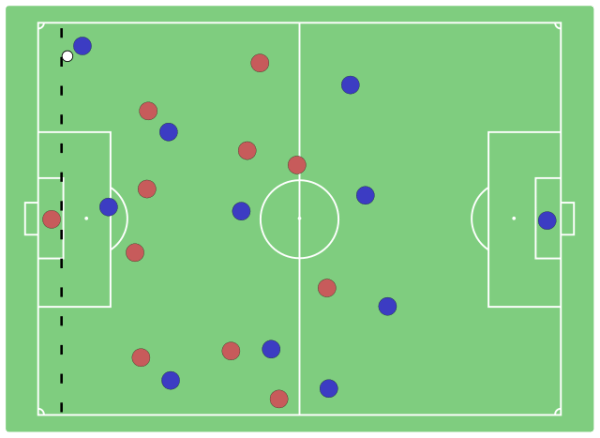
FIFA has implemented what they call “semi-automated offside technology” this World Cup. It is supposed to be an improvement on the currently used technology, but early in the tournament offsides have been a source of some controversy among fans. We take a deeper look into the offside rule and the latest technology.
What is the offside rule in football?
The offside rule is arguably the least understood aspect of football that plays a defining part in shaping the game as we know it. The point of the offside rule is to prevent attacking players from perpetually camping in front of the opponent’s goal. This means that an attacking player can enter the space between the final defensive player (most often the goalkeeper) and the rest of the defence only after the ball is played. An offside offence leads to the attacking team losing the ball and conceding a free-kick from the point where the attacking player was deemed to be offside.
The offside rule is at the heart of how football teams attack and defend. Defensive lines keep their shape and move in unison, along the same horizontal plane with the knowledge that attacking players cannot legally settle down behind the line until the ball is played. This allows defences to step out higher in the pitch, consequently moving the whole team up and is key to possession-based football.
On the other hand, one of the most crucial skills for attackers is to time their forward runs perfectly so that they are either level or behind the defensive line at the time the pass is played. This way, the offside rule rewards pace, precision, and skill from the attackers and defenders.
 The blue forward on the left of the diagram is in an offside position as he is in front of both the second-to-last defender (marked by the dotted line) and the ball. Note that this does not necessarily mean he is committing an offside offence. (Via Wikimedia Commons)
The blue forward on the left of the diagram is in an offside position as he is in front of both the second-to-last defender (marked by the dotted line) and the ball. Note that this does not necessarily mean he is committing an offside offence. (Via Wikimedia Commons)
 The blue forward in the penalty area of the diagram is not in an offside position, as they are behind the ball, despite the fact that they are closer to the opponents’ goal line than the second-last opponent. (Via Wikimedia Commons)
The blue forward in the penalty area of the diagram is not in an offside position, as they are behind the ball, despite the fact that they are closer to the opponents’ goal line than the second-last opponent. (Via Wikimedia Commons)
According to the International Football Association Board (IFAB), the body in charge of the laws of the game, “a player is in an offside position if, any part of the head, body or feet is in the opponents’ half (excluding the halfway line), and any part of the head, body or feet is nearer to the opponents’ goal line than both the ball and the second-last opponent.”
Further, “a player in an offside position at the moment the ball is played or touched by a team-mate is only penalised on becoming involved in active play.”
Without the offside rule, football might become a game where the attacking team pushes as many players as possible into the opponent’s area and continuously spams long balls to them. There would be no incentive for defences to step out and the only way attacking teams could create advantages would be to numerically overwhelm defences in a small area of the pitch. Football would look very different.
How have offsides been determined thus far?
Traditionally, offsides have been the jurisdiction of the two linesmen or lineswomen, one on either side of the pitch. They try to stay in the same horizontal plane as the defensive line (more technically, the second last player on defence). While linesmen continue to be in the game, today, they are aided by technology to make more accurate decisions that would be simply impossible to make with the naked eye.
After all, the rule needs the line referee to look at both the moment the pass is played and the position of the attacking player at the same time. This can be very challenging when the pass is played from a position deeper in the pitch and the attacker is not in the same visual space.
Thus, the video assistant referee (VAR) was introduced for offsides specifically after a particular play led to a goal-scoring action. Thus if a player receives the ball in an offside position and scores a goal, the goal would be overturned. Further, the line referees were ordered to not play make an offside call until the goal-scoring move was finished. This meant that they would no longer be able to mistakenly call an offside, robbing a team of a legal goal.
The older technology (technology still used by most football tournaments including the English Premier League) used by the VAR for calling offsides relied on the VAR looking at replays, manually determining the point of last contact by the passer and freezing the frame. Then, with some assistance from computers, horizontal lines determining the position of the attacking player as well as the second to last defender were plotted on that frozen frame.
If the attacker’s line was closer to the goal than the defender’s, it was deemed to be an offside. At the outset, this method has some evident issues. Firstly, it is impossible to accurately depict actual 3D space on a 2D image. Secondly, it is actually quite difficult to determine the exact point of contact for the passer. The difference between two frames can very easily be a difference between an offside and not.
What is FIFA’s new system like?
According to FIFA, “The new technology uses 12 dedicated tracking cameras mounted underneath the roof of the stadium to track the ball and up to 29 data points of each individual player, 50 times per second, calculating their exact position on the pitch. The 29 collected data points include all limbs and extremities that are relevant for making offside calls.”
Further, “Al Rihla, adidas’ official match ball for Qatar 2022, will provide a further vital element for the detection of tight offside incidents as an inertial measurement unit (IMU) sensor will be placed inside the ball. This sensor, positioned in the centre of the ball, sends ball data to the video operation room 500 times per second, allowing a very precise detection of the kick point. “
The new technology combines limb tracking and ball tracking, and with the help of artificial intelligence, it creates a 3D model of the happenings on a football pitch at all time, providing the most accurate detection of offsides to date.
Why the controversy, then?
Simply put, the system seems to be too accurate. So far, the controversy surrounding offsides in the World Cup has been about goals that have been disallowed due to an offside in the build-up. Case in point, Lautaro Martinez’s disallowed goal for Argentina on Tuesday. The offside call was marginal, to say the least.
Had Martinez’s upper body been an inch behind where he was, he would not have been offside, the goal would stand, and Argentina would take a 2-0 lead against Saudi Arabia before the 30th minute. The match where they eventually lost to the upstart Arabians could have ended very differently.
In past tournaments, there is next to no chance that Martinez would have been called offside. Looking with the naked eye, he very much looked in line with the defender. Even with the previously used VAR technology, there is a good chance that he would have received the benefit of the doubt in such a close call. After all, he did not really gain much of an advantage by making the run a tenth of a second in advance.
This issue actually previously surfaced when VAR was first introduced. According to former Arsenal manager Arsene Wenger and current FIFA chief of global development, a new offside rule to promote attacking, attractive football needs to be introduced. He said to L’Equipe in 2020, “I would like it to be that there is no offside so long as a [single] body part which a player can score with is in line with the defender. This could be too much of an advantage for an attacker, because that obliges the defenders to play higher up.”
This would be a departure from today’s rules where not even one body part with which a player can score can be ahead of the final defender, effectively eliminating the margin calls as we see today.